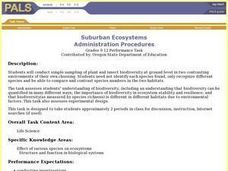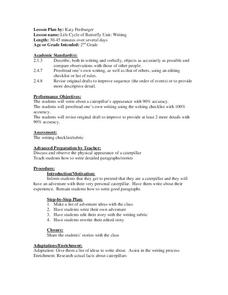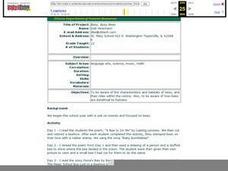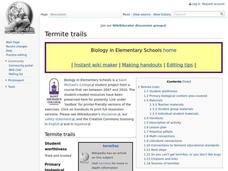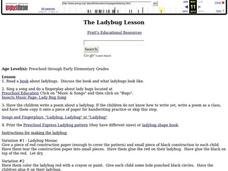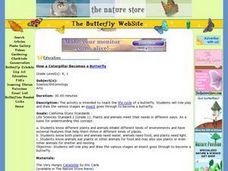Curated OER
Creating a Shelter
First graders create a small usable shelter for a small animal or an insect. For this shelter lesson plan, 1st graders use popsicle sticks, tree twigs, bottles, and more to build a shelter in groups.
Curated OER
Primary And Secondary Succession
Students cover the topics of primary and secondary succession with interest to its ties in the study of ecosystems. They study how the introduction of an insect can effect the ecological balance. Students make predictions and write them...
Curated OER
Classifying Living and Non-Living Objects
Students investigate living organisms and define the properties of a living species. In this life characteristic lesson plan, students examine plants in their class and discuss whether or not they are alive. Students create a living...
Curated OER
Suburban Ecosystems
Students conduct simple sampling of plant and insect biodiversity at ground level in two contrasting environments of their own choosing. They recognize and record different species then compare and contrast species numbers in the two...
Curated OER
Leo and the Butterflies
Second graders read a book entitled, "Leo and the Butterflies." They discuss the rainforest and butterflies. Students observe the pictures and predict what will happen in the story. They examine reading strategies for decoding unfamiliar...
Curated OER
Science: Finlay and Yellow Fever
Ninth graders research the work of Carlos J. Finlay and his contributions to science. Once they have discussed his theories about diseases, they create tables comparing diseases that use insects as carriers. The lesson also includes a...
Curated OER
Life Cycle of Butterfly
Second graders investigate life cycles of insects by writing a story. In this butterfly life lesson, 2nd graders create a checklist of the many steps a caterpillar takes before growing wings and flying. Students utilize creative...
Curated OER
Vermicomposting
Fourth graders explore insect life by viewing a soil presentation in class. In this composting instructional activity, 4th graders read assigned text about the process of composting soil and the necessity of soil in plant life. Students...
Curated OER
Busy, Busy Bees
Students role play bees finding nectar. they put on bee tails and antenna. Then 3 or 4 students at a time performed the dances bees do when one is communicating to the others that he has found nectar and the when they are close the...
Curated OER
Dirt Life
Students select and collect soil samples from a variety of locations (schoolyard, home, etc.). They do this lab after an interest-generating discussion about "dirt" and microbes. Students make a dilution in sterile water, plate it on a...
Curated OER
COMPARE SOILS BY GROWING PLANTS
The student will identify the difference in the rate of plant growth in three soils that vary in organic matter.1. Obtain three to four flowerpots, different types of soil, a record chart, three to five beans for each pot, and water....
Curated OER
Critters in Your Own Backyard
Pupils identify various animals and their habitats, as well as their specific traits In this animal habitat lesson, students list animals they've seen in their backyard. Pupils select one animal and do research. Students then answer 9...
Curated OER
Arthropod Mouth Parts and Food
Students identify the different types of mouths arthropods have for eating various types of food. Given photographs of the different types of arthropods, students identify which mouth they have and what type of food they can eat with...
Curated OER
What Are Ecosystems?
Third graders recognize and examine ecosystems. They observe and describe habitats within ecosystems and observe and identify organisms with similar needs that compete for resources.
Curated OER
Termite Trails
Students observe termite trail-following behavior. In this termite trails lesson, students draw a circle or other shape approximately eight inches across with a ball point pen. Teacher taps out termites into the circle and request that...
Curated OER
The Ladybug Lesson
Students explore the traits of ladybugs. In this ladybug lesson, students read books, sing songs, and learn fingerplays about ladybugs. Students also create their own ladybugs.
Curated OER
The Very Hungry Caterpillar Puppet Book
First graders create their own puppet book to go with "The Very Hungry Caterpillar" book.
Curated OER
How a Caterpillar Becomes a Butterfly
Student role play and draw the various stages an insect goes through to become a butterfly. They discover the different stages of how a caterpillar becomes a butterfly. Students read The Very Hungry Caterpilla by Eric Carle.
Curated OER
Food: Unusual Dishes From Around the World
Students access a variety of unique food from around the world themed websites. They locate information about foods that Americans might find strange like monkey brains, insects and snakes. They view recipes and photographs.
Curated OER
Making a Human Tree
Young scholars explore botany by defining the anatomy of a tree. For this environmental exploration lesson, students research plant vocabulary terms and discuss the uses of each word. Young scholars create a "human" tree by role-playing...
Curated OER
Web of Life - Ecosystem
Third graders play the roles of various organisms in an ecosystem (focusing on insects) and pass yarn or string around to other organisms from largest animals to the smallest. The end product is a web which shows how all of these animals...
Curated OER
Bringing Illinois into the Curriculum
Students of all ages are introduced to the geography of Illinois. Depending on the grade level, they participate in different activities which allow them to discover Illinois in the past and present. They examine the animals and...
Curated OER
Crazy Critters
Eighth graders visit a local park to collect insects. They record the habitats, identify the insect and write a report including the kingdom, phylum, class, and order.
Curated OER
"Bug Hunt"
Fourth graders find bugs represented on a grid and then identify their name and physical characteristics that provide a picture of the bug using imagery.





